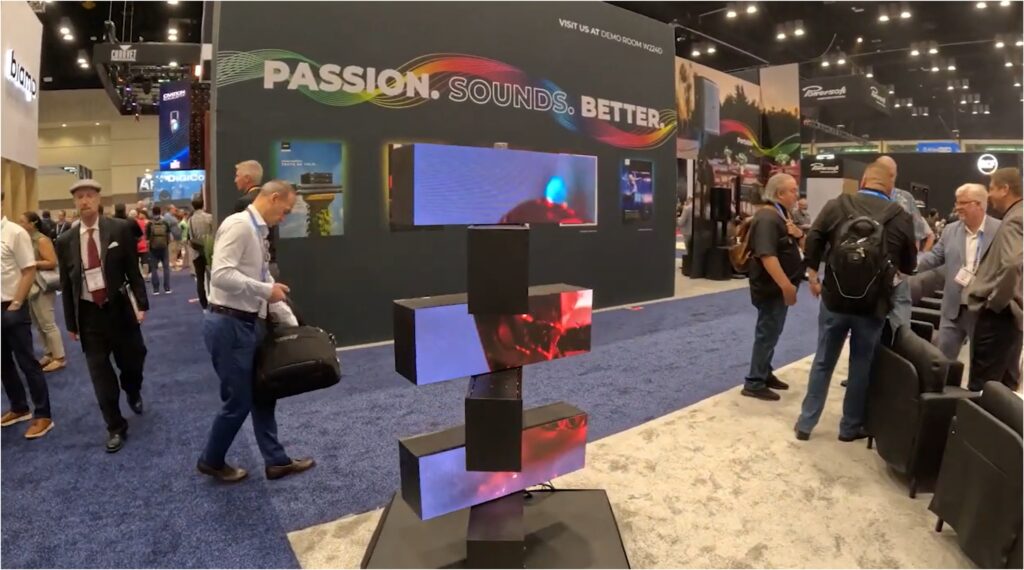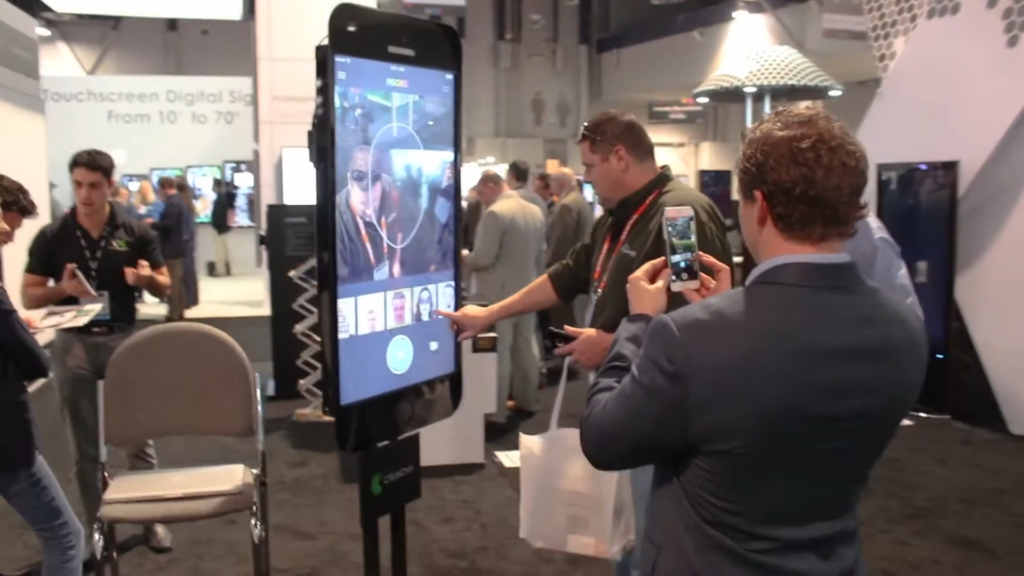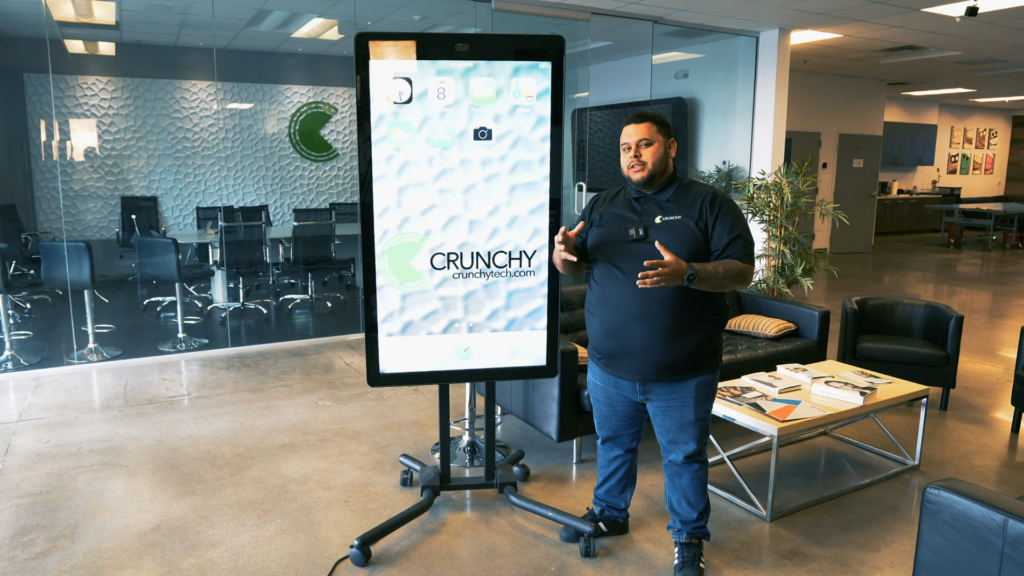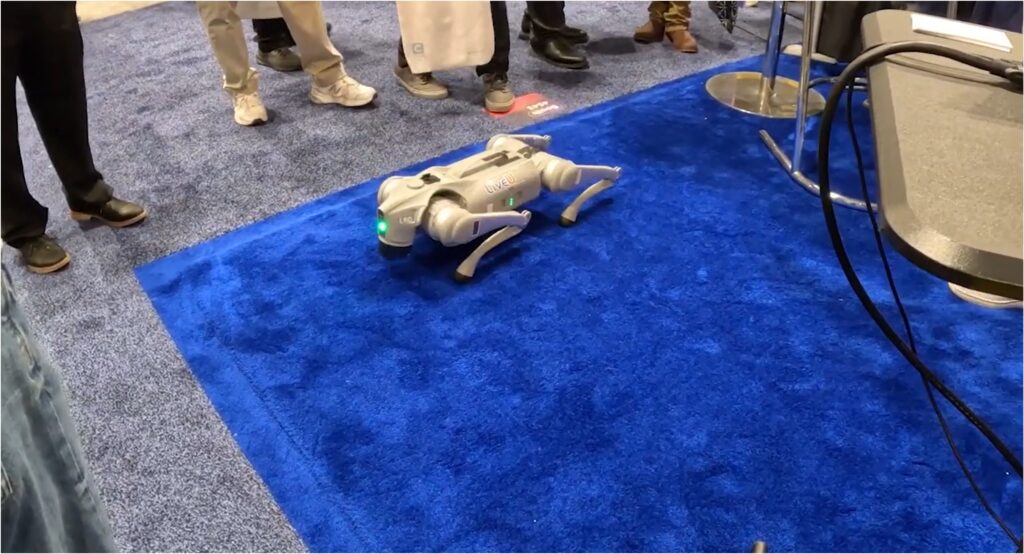Trade shows are a staple in business-to-business (B2B) marketing. Companies from various industries invest tens of thousands in them on booth space, flights, hotel rooms, and a setup crew with the knowledge that it’s a highly effective marketing and lead generation strategy when done right (“when done right” being the operative words).
If you’re keen on standing out in your next expo event attendance, whether it’s your first time or have been a frequenter at expo halls, here we’re pulling the curtain on how trade show marketing works in 2025, alongside practicable strategies you can implement before, during, and after the exhibit. Let’s go!
Key Takeaways
- Trade show marketing is a full strategy before, during, and after the event.
- Pre-show hype builds anticipation and gets you on people’s must-visit list.
- Your booth needs to do something. Touchscreens, demos, games, and live activations beat static trade show displays nearly all the time.
- Staff matters. The right people, trained well, make or break your booth experience.
- Technological integration gives you the edge. Use experiential displays, lead capture apps, and real-time analytics to work smarter.
- Follow up fast. No one remembers you a week or two later if you don’t stay in their inbox.
- Measure ROI with real metrics (leads, meetings, pipeline), not just “felt busy.”
- Stay ahead with 2025 trends: AI personalization, gamified experiences, sustainability, and hybrid-ready booths.
What Is Trade Show Marketing?

Trade show marketing is a promotional strategy for brands to show off, stand out, and sell at live industry events. It’s your business going full stage mode: booth, banners, demos, cool giveaways, team polos, the works.
All in the hopes of attracting buying-mode attendees, as well as networking with fellow professionals, staying up-to-date with industry trends, and even observing competitors to find opportunities for differentiation.
Marketing at trade shows comprises attracting the right people, telling a clear, engaging story, and turning that 10×20 space into a lead-capturing machine.
Here’s what it usually includes:
- Pre-show hype: Email marketing campaigns, social teasers, maybe even a “see us at Booth #218” in your email signature.
- On-the-floor magic: Custom trade show booth design, signage, interactive experiences, product demos, and yes, those branded socks people weirdly love.
- Post-show follow-through: Lead nurturing, follow-up emails, personalized LinkedIn connects. (You are following up, right?)
Whether you’re launching a product, building buzz, or trying to close deals face-to-face, it’s how you make your trade show presence felt and remembered.
Why Trade Show Marketing Works (When It’s Done Right)
In-person events are very much alive in 2025. But most trade show booths are either trying too hard or hardly trying.
When a brand actually nails it it hits different. People stop. They talk. They remember. Here’s why trade shows and conventions marketing still works in 2025 (and probably always will):
Face-to-face still beats inbox-to-inbox
You can’t fake a handshake, a smile, or a solid product demo. Relationships move faster when you’re not hiding behind a digital screen.
Buyers are there to buy
These aren’t random walk-ins. Trade show attendees want to discover something new. They’re in decision-making mode; which means real pipeline, not just vanity metrics.
You’re in a room full of competitors
And guess what? Most of them are boring. That’s your opportunity to steal the spotlight and get a leg up on the competition.
Instant feedback
See what people actually react to: your pitch, your visuals, your product or service. It’s a live focus group with a badge scanner.
So yes, trade show event marketing works. But only if you show up ready to market. Not just sit behind a table with a fishbowl full of business cards with nothing to actually convince attendees you’re worth their time.
Types of Trade Show Marketing Tactics
Trade show marketing isn’t only about what happens at the show. It’s a full-court press: before, during, and after the trade show exhibit. Skip a phase, and you’re wasting budget.
Here’s how smart brands attack every angle:
Before the Show: Build the Buzz
Start early. Don’t wait until the week of the show to tell people you’ll be there. Warm up your audience weeks in advance. Utilize digital marketing outlets such as email, social media, as well as personal outreach to tease what you’re bringing.
Better yet, give them a reason to pay your booth a visit: exclusive demos, giveaways, or a first look at something new.
At the Booth: Be Worth Stopping For

This is the main event. You’re surrounded by a hundred other booths fighting for attention in a bustling trade show environment. If your setup blends in, you lose. Go beyond banners and create a brand experience. Let people touch, play, interact.
Product demos should be hands-on. Presentations should be short and bold. Screens should move. And your staff must be trained to engage, not just halfheartedly hand out flyers.
Live Activations: Create a Moment
Want a crowd? Do something that pulls people in live. A product drop, a surprise giveaway, a competition with a scoreboard. These are the things that get phones out and conversations started. If you make people feel like they’re in on something special, they’ll stick around and even tell others.
After the Show: Don’t Vanish
Here’s where most brands blow it. They collect leads, pack up, and go dark. Big mistake.
You need to follow up as quickly as you can and with intention. Mention what they saw, remind them what you talked about, and make the next step easy. A thoughtful follow-up can do more than any glitzy booth.
How to Build a Trade Show Marketing Strategy That Doesn’t Flop
If your strategy is “show up and see what happens,” you’ve already lost. The brands that win trade shows plan like it’s a military operation. Goals, targeting, booth flow, follow-up. It’s all mapped out before the crates even ship.
Here’s how to build a trade show marketing strategy that moves the needle.
Know Why You’re There (And What You Want Out of It)
Start with your goals. “Raise awareness” is vague.
- Are you launching a new product?
- Trying to book demos?
- Collecting leads for your sales team?
Different goals = different booth designs, different calls-to-action, different staff scripts. Define trade show success prior to the event.
Pick the Right Show and the Right Spot
Not every trade show is worth your time. Choose events that bring the right, purchase-ready buyers. A niche show with 500 decision-makers beats a mega-show full of tire kickers.
And once you’ve picked a show, fight for booth placement. Near the main entrance? Great. Next to the coffee station? Even better.
Say Something People Actually Understand
Your signage should say exactly who you help and what you do in seconds. No buzzwords. No ambiguous “solutions.” If someone has to ask, “So… what do you guys actually do?” that’s on you. Test your messaging with people outside your company. If they don’t get it, rework it.
Design a Booth That Does the Work for You
Don’t just make it pretty. Make it functional. Where will people stand? How will you do the demo? Is there space for conversations? For charging phones? For scanning badges without awkward crowding?
The best booths guide visitors through a flow—attract, engage, convert—without making them feel like they’re trapped in a sales pitch.
Train Your Team (They’re the Real Booth)

People remember your representatives more than your signage. Train your team to be curious, not pushy. To start real conversations, not rattle off features.
And for the love of all things branded, make sure they’re not staring at their phones.
Trade Show Marketing Technology That Gives You an Edge
Your booth isn’t competing with the other 10×10 across the aisle. It’s competing with everything grabbing attendees’ attention: other booths, their inbox, their phones, their aching feet.
If you want to win that fight, tech is your unfair advantage.
Screens That Do More Than Play Slideshows
Forget passive displays. Interactive screens like the Padzilla giant iPhone let attendees actually do something, be it play a game, explore your product, take a quiz, or sign up for a demo.
When people touch the screen, they engage longer and remember more. That’s the difference between “cool booth” and “who were those guys again?”
Lead Capture That Doesn’t Make You Look Clueless
Still writing names on paper? Yikes. Smart booths use digital lead capture tools, namely QR code scans, badge integrations, tablets with form logic. But the best setups go beyond that. They segment leads in real time, tag interests, and push data straight to your CRM. No lost info. No forgotten convos.
Gamification That Feels Less Gimmicky, More Genius
Use booth technology to gamify your trade show experience without feeling like a state fair. Think digital trivia, interactive vending machines, leaderboard contests, or AR scavenger hunts. If it’s fun and on-brand, you’ve got a line forming by noon.
Analytics That Actually Tell You Something
Some tech just looks superb. The good stuff also tells you what worked. How many people engaged? What did they click on? How long did they stay? The more you know the better your next booth gets and the easier it is to prove ROI when the budget review rolls around.
Common Trade Show Marketing Mistakes (And How to Dodge Them)
Most trade show failures don’t happen on the show floor. They happen before the crates even ship—when teams cut corners, skip planning, or assume the booth will “just run itself.” (Spoiler: it won’t).
Here’s how brands shoot themselves in the foot and how to walk around those landmines.
Showing Up Without a Game Plan
If your goal is “just be there,” congrats, you nailed it. But don’t expect results. Walking into a show without clear objectives, measurable KPIs, or a booth strategy is like tossing money into a crowd and hoping it comes back.
Thinking a Cool Booth Is Enough
A charming booth might stop people for five seconds. But if there’s no reason to stay—no story, no engagement, no experience—they’ll keep walking. Eye-candy visuals get attention. A great interaction gets remembered.
Staff That Doesn’t Know What They’re Doing
Bad booth staff is a silent killer. If your team is dog-tired, distracted, or unprepared, it reflects directly on your brand. And trust us, attendees notice. The best reps are energized, trained, and know how to start real conversations (without cornering people like it’s a timeshare pitch).
Forgetting to Market the Booth Itself
The booth isn’t the product, the invitation is. If no one knows you’re exhibiting, or why they should care, the rest doesn’t matter. Promote the booth like you’d promote and showcase a product launch. Teasers, sneak peeks, countdowns, partnerships, giveaways. HYPE IT UP.
Dropping the Ball After the Show
The worst offense? Doing all that work and then ghosting your trade show leads. If your team collects badge scans and then sits on them for a week (or worse, forever), you just turned your most expensive campaign into a networking hobby.
Measuring ROI in Trade Show Marketing
If you can’t measure it, you can’t defend it. And if you can’t defend it, you can kiss next year’s B2B marketing budget goodbye.
Trade shows feel exciting in the moment. But unless you’re tracking the right stuff, all that buzz fades fast. ROI is less about how busy your booth felt and more about what that foot traffic turned into after the lights went down.
What to Ideally Track (Beyond the Vibes)
Let’s move past the “we had great conversations” talk. Here’s what real ROI and trade show participation success looks like:
- Qualified leads captured – not just badge scans, but real people who showed genuine interest.
- Demos booked or meetings held – scheduled follow-ups = buying intent.
- Pipeline influenced – how many deals can be directly tied to the show?
- New contacts from target accounts – especially those hard-to-reach ones.
- Email open rates and post-show engagement – did they stay in touch?
And yes, brand impressions, social buzz, and booth visits still matter. But they should support the numbers that close deals.
Use Tools, Not Gut Feelings
Use lead capture applications that sync with your CRM. Tag leads by interest, stage, or product. Track how many converted into real opps later. If you’re running interactive tech, pull usage data. Know who clicked what, for how long, and whether they handed over their info afterward.
Even something simple, such as A/B testing two giveaway strategies, can give you better insight for next time.
Proving Value to the Higher-Ups
You don’t need a 20-page report. Just tie outcomes to goals.
Did you say you were going to book 30 demos and you booked 42? Say that.
Did you want to meet 10 new decision-makers and walk out with 18? Say that.
Keep it tight, keep it data-backed, and make sure it shows movement toward revenue.
Bottom line? If your trade show feels like a blur and you’re not sure what came from it, you didn’t measure right. Set the metrics before the show and it’ll be way easier to prove it was more than a good time and a free tote bag.
2025 Trends in Trade Show Marketing

While some booths are still tossing stress balls and calling it a day, others are leveling up with smarter tech, tighter targeting, and better storytelling. If you want to keep up (or better yet, leap ahead), here’s what’s setting the pace this year.
AI-Driven Engagement
We’re not talking about clunky chatbots. We’re talking about real-time lead scoring, AI-curated content displays, and personalized trade show experiences based on who’s in front of the screen.
Want to impress a CTO? Let the booth show them a demo tailored to their industry. That’s artificial intelligence doing real work and not just buzzword bait.
Touchscreens + Interactive Storytelling
Screens are tools to guide a conversation. Whether it’s a product tour, a pricing calculator, or a trivia game that grabs lead info at the end, most people prefer to tap, swipe, and explore on their terms. The more they interact, the longer they stay and the more they remember.
Gamification Without the Gimmicks
Today’s games are built with purpose. Think: trivia tied to your product. Digital scavenger hunts with QR checkpoints. Vending machines that reward engagement, not just attendance. It’s all about play with a payoff.
Sustainability in Booth Design
More brands are ditching the waste and gearing more towards sustainable marketing. Modular booths that can be reconfigured. Recycled materials. Digital handouts instead of piles of print. Sustainability is a smart talking point. Especially if your audience includes Gen Z buyers or ESG-conscious execs.
Hybrid Events Are Quietly Sticking Around
Live is still king, but smart marketers are thinking beyond the trade show floor. Livestreaming demos, creating digital-only exclusives, and building post-show content libraries keep the booth alive long after teardown. If you’re not capturing content while you’re there, you’re missing half the value.
Winning Trade Show Marketing Ideas & Examples
It’s one thing to talk strategy. It’s another to see it in action. The best booths give attendees a reason to stop, interact, and remember them weeks later. Here are a few standout ideas and examples of trade show marketing done impeccably.
Vending Machine That Pulls a Crowd
A B2B SaaS brand can build a skinned vending machine that handed out prizes, like t-shirts, power banks, mystery boxes. The catch? You have to scan a QR code and answer a quick quiz about their product to get a prize.
| WHY IT WORKS: Engagement with a purpose. It filters out the freebie hunters and educates people at the same time.
Product Demo Meets Playground
A robotics company ditches the slide deck and builds a live test track in their booth. Attendees could control the robots themselves, run obstacle courses, and compete for prizes.
| WHY IT WORKS: Hands-on interaction. People stay longer, ask deeper questions, and post videos that can give the booth viral legs.
Touchscreen-Powered Exploration with Padzilla
One exhibitor uses Padzilla to let attendees explore their full product catalog through an oversized touchscreen experience. Each product has a short demo video, specification sheet, and a “book a meeting” button built in.
| WHY IT WORKS: Self-guided discovery. Visitors move through at their own pace, interact with real content, and book follow-ups without needing a pitch.
Trivia That Collects Leads Like Crazy
A cybersecurity company launches a 60-second trivia game on a large screen. Play the game, enter your email, see your score on the leaderboard. The top 10 each day wins prizes.
| WHY IT WORKS: Competition. People queue up, challenge their coworkers, and happily give their info in the process.
Trade Show Event Marketing Is Evolving. Are You?
The badge scans. The foot traffic. The product demos. All of it can be gold or a complete waste depending on how you show up.
You don’t need a gimmick. You need a game plan. A reason for people to stop. A story they can touch. And a way to turn “just browsing” into, “let’s talk next week.”
Make your next booth unmissable with Padzilla. Book a demo today!

